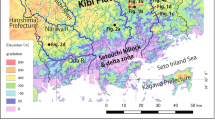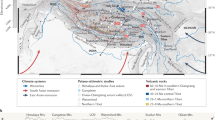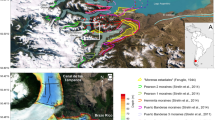Abstract
A UNIQUE feature of the geology of the Himalayas is the presence to the north of the Great Himalayan Range of a complete sequence of marine fossiliferous rocks ranging in age from the Cambrian to Eocene and an enigmatic absence of fossils in the pre-Tertiary sediments lying to the south of the range1. A notable exception is found in Kashmir where fossiliferous Cambrian to Jurassic marine rocks lie to the south of the Great Himalayan Range as a result of the Kashmir Nappe2. Geologists working in the Himalayas have tried to explain this anomaly by erecting a hypothetical barrier between the northern and southern basins to prevent the migration of animals and plants from north to south. This barrier was called by Wadia3 a “geanticline within the main geosyncline”, Pande and Saxena4 thought that the geanticline or central barrier was formed during the Ordovician times. Fuchs5 named this imaginary barrier “Himalayan Ridge” and thought that it was formed after the Caledonian orogeny. It has also been suggested that this geanticline or ridge has been subjected to denudational processes since its origin in the early Palaeozoic times, but it has become the highest mountain range in the world and it is still rising.
This is a preview of subscription content, access via your institution
Access options
Subscribe to this journal
Receive 51 print issues and online access
$199.00 per year
only $3.90 per issue
Buy this article
- Purchase on Springer Link
- Instant access to full article PDF
Prices may be subject to local taxes which are calculated during checkout
Similar content being viewed by others
References
Burrard, S. G., and Hayden, H. H., Geography and Geology of the Himalayan Mountains and Tibet, 208 (Calcutta, 1907–1908).
Wadia, D. N., Rec. Geol. Surv. Ind., 68, Part 2, 123 (1934).
Wadia, D. N., Geology of India, 420 (Macmillan and Co. Ltd, London, 1966).
Pande, I. C., and Saxena, M. N., Birth and Development of Himalaya 5 (Publication No. 4 of the Centre of Advanced Study in Geology, Chandigarh, 1968).
Fuchs, G., 23rd Int. Geol. Congr., 3, 168 (1968).
Holmes, A., Principles of Physical Geology, 1224 (Thomas Nelson and Sons Ltd, London, 1965).
Wegener, A., The Origin of Continents and Oceans (Methuen, London, 1924).
Gansser, A., Eclogae Geologicae Helvetiae, 59, No. 2, 842 (1966).
Author information
Authors and Affiliations
Rights and permissions
About this article
Cite this article
JAIN, S., KANWAR, R. Himalayan Ridge in the Light of the Theory of Continental Drift. Nature 227, 829 (1970). https://doi.org/10.1038/227829a0
Received:
Issue Date:
DOI: https://doi.org/10.1038/227829a0
This article is cited by
-
A possible Himalayan microcontinent
Nature (1976)
-
Problems in Himalayan geology
Geologische Rundschau (1973)
-
Discovery of Pre-tertiary Fossils indigenous to the Lower Himalayan Basin
Nature (1971)
Comments
By submitting a comment you agree to abide by our Terms and Community Guidelines. If you find something abusive or that does not comply with our terms or guidelines please flag it as inappropriate.



